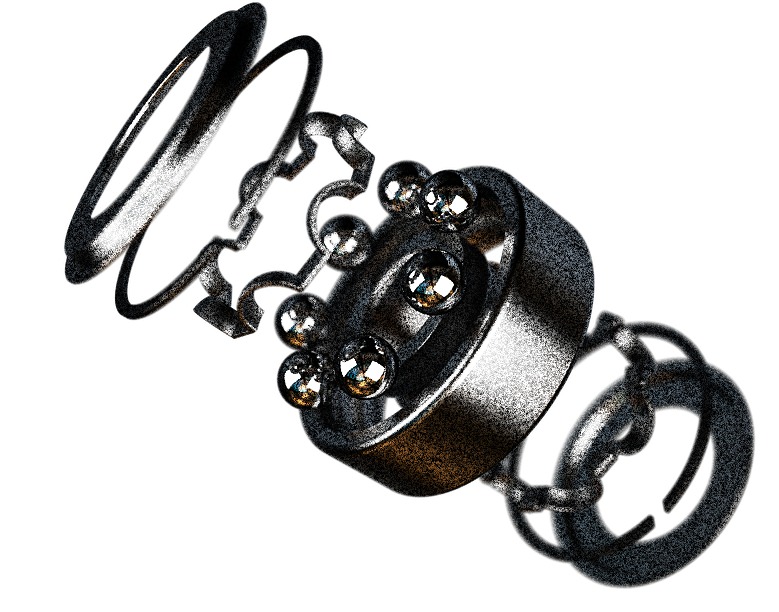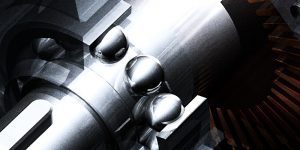The manufacturing of ball and roller bearings is a mature industry and the basic technology for it has been around for decades.
Technological innovations in the industry in the late 1990s focused on the use of new and sometimes exotic materials, more efficient bearings and bearings specially designed for tighter market applications.
 Steel has traditionally been the main component of ball bearings due to its strength and the existing technology for its manufacture and machining. Ball bearing manufacturers and a steel companies are increasing their steel-range for bearings.
Steel has traditionally been the main component of ball bearings due to its strength and the existing technology for its manufacture and machining. Ball bearing manufacturers and a steel companies are increasing their steel-range for bearings.
In the 1920s various bearing companies introduced spherical and tapered roller bearings. Many companies supply the automotive components such as automatic transmission bearings and parts, steering columns and precision machines including linear guides and ball screws.
The design of all the cages used in industrial bearings ensure that all contact surfaces are well lubricated, even if the lubricant supply is occasionally interrupted. The results in greater performance and service life.
These type of bearings have an improved ability to absorb dynamic loads and a lifespan up to three times longer than the previous standard, which is superior to all other conventional cylindrical roller bearings.
The performance improvements cylindrical roller bearings over the past 100 years have made it possible to downsize components while maintaining the required performance.
Tapered roller bearings have dimensional stability and a long service life, even with contaminated lubricants. They offer a durable steel cage and are dimensionally interchangeable with other bearing manufacturers. If the likelihood of misalignment is high, spherical roller bearings are the better choice.
Historical Ball Bearing Designs
There are various common ball bearing designs that have been developed, each offering different compromises. They can be made from many different materials, including stainless steel, chrome steel and ceramic.
A hybrid ball bearing is a bearing with ceramic balls and metal rings. An axial load runs through the bearing in a straight line, while a radial load takes an oblique path that tends to axially separate the races.
Ball bearings have a spherical shape, while roller bearings are cylindrical and can be tapered or flattened at one end to resemble needles. In a typical production process, pieces of wire are cut off in a press, placed between dies and pressed into the shape of a ball or roller. The fin of excess material created during the pressing process is removed between rotating file disks and the diameter of the bearings is reduced by grinding and tumbling processes.
The ball bearings are placed between the surfaces of two cast iron disks, where they run in grooves. The inside of the grooves is rough, causing the lightning to tear off the balls.
The stationary wheel has holes so that the balls can be inserted into and removed from the grooves. A special conveyor feeds balls into one hole, the balls rattle around the groove and then come out of the other hole.
In these bearings, the rolling part is a ball that rolls between the inner and outer rings, which are called races. The balls are held by a cage that keeps them evenly distributed around the races. In addition to these parts, there are many optional parts for special bearings, such as seals to keep out oil or grease and dirt, or screws to keep a bearing in place.
Bearing Sturdiness
The stiffness of a bearing indicates how the distance between the parts separated by the bearing changes with the load applied. In the case of rolling bearings, this is due to the load on the ball and race. For fluid bearings, this is due to how the pressure of the fluid changes with the gap (when properly loaded, fluid bearings are typically stiffer than rolling bearings).
A bearing is a machine element that restricts the relative movement only to the desired movement and reduces the friction between moving parts.
The bearings are roughly classified according to the type of operation, the permissible movements or the directions of the loads (forces) acting on the parts.
Rotary bearings hold rotating components such as shafts or axes in mechanical systems and transfer axial and radial loads from the load source to the structure that supports them. The simplest form of bearing, the plain bearing, consists of a shaft that rotates in a hole.
This bearing deals extensively with certain cases such as front and rear wheel hubs, rear axles and transmissions, with the space prohibiting this article from dealing with anything other than the latter. There are drawings you can find on the internet showing the subtle difference between the gearboxes typical of 1910, in which the bearings are correctly and/or incorrectly installed.
The main shaft plain bearings are assembled in the same way. The adjustment of the two thrust bearings is obviously done by the outer races of the two outer bearings, by two special washers on the two individual thrust bearings. Then by the inner races of the two plain bearings on the shoulders of the drive and main shafts, the thrust between these two being based on two button-shard steel is done inside the drive shaft.
Ball bearings are great for radial loads, but roller bearings with more surface along the roller than the point contact of a ball are even better.
That summarizes some of the history of ball bearings used in manufacturing. Feel free to leave your comments below.






